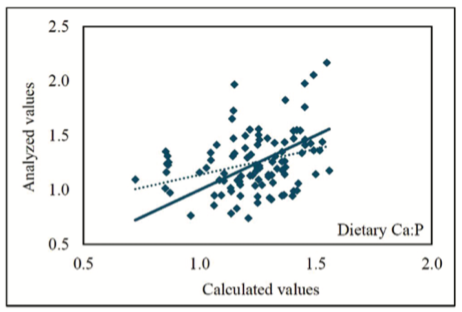
Research Note
Calcium Caution:
Uncounted Excess Hurts Performance
Recent research points to excess dietary calcium as a drag on pig growth performance, particularly affecting younger pigs. It can reduce average daily gain in growing pigs by 50-100 g.
 The challenge is not diet formulation itself, suggests Dr. Hans Stein at the University of Illinois. Rather, it’s accounting for all the sources of calcium (Ca) in the final ration.
The challenge is not diet formulation itself, suggests Dr. Hans Stein at the University of Illinois. Rather, it’s accounting for all the sources of calcium (Ca) in the final ration.
He notes that those who formulate the diet or manufacture the ration may not be aware of all the possible Ca sources: “But, if you add them all up, you can get way too much.”
Excess Ca mainly comes from calcium carbonate (CaCO3) in the form of limestone added in small amounts to feed ingredients as an inexpensive “anticaking” or flow agent. In the case of various types of soybean meal, for example, AAFCO (Association of American Feed Control Officials) sets the maximum inclusion at 0.5%.
However, Stein points out, there are many other sources, including in premixes where limestone may be used as a carrier for vitamins or as a densifier to adjust bulk density. He cautions that Ca concentrations in DDGS (distiller’s dried grains with solubles) can be “extremely variable.”
A study of commercial swine feed products in Europe found they averaged 0.22% more Ca than stated on the label. Comparable work in Stein’s lab — sampling commercial and integrated rations for nursery pigs, grow-finish pigs, or sows in eight major swine producing states — found an average of 0.19% more Ca than formulated. By contrast, for total phosphorus (P), the average oversupply was only 0.06%.
Total Ca:P ratio in U.S. swine diets — regression (dotted line) of analyzed values on calculated values in relation to the expected outcome (solid line, X = Y). Note: Adapted from Figure 3, L.V. Lagos et al., 2023
The ratio of Ca to P is key because excess dietary Ca can reduce P digestibility, feed intake, and growth performance. Diets already marginal in P are especially problematic. Given excess Ca, increasing P can be an option, except dietary sources are costly and may cause additional P excretion.
Researchers in Stein’s lab found that to maximize average daily gain in pigs 11-22 kg (roughly 25-50 lb), the ratio of standardized total tract digestibility (STTD) Ca to P needs to be less than 1.40:1.0. Other research has found that the Ca:P ratio optimal for growth decreases with increasing body weight.
In diet formulation, enzyme additives also may be a factor, especially as microbial phytase increases the digestibility of both Ca and P. In any case, Stein says, it’s critical not to over-feed Ca.
“Prior to diet formulation, know the actual calcium concentrations of all calcium-containing ingredients and premixes. Analyze rations periodically to confirm that concentrations match the formula.”
Questions?
Email FeedInsight 4Swine


